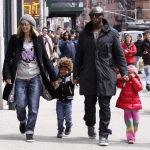Adoption: Why I Placed My Daughter in a New Home

In that time my daughter McKenna has become a happy memory and I understood only a few years ago for the first time in my heart what one birth mom told me a long time ago – that it would get to be like I have a child out there somewhere and that she was happy but I wouldn’t get sad every time I thought of her and that she would be like a long-lost relative.
It was a weird feeling back in 2001 and one that I never thought I would get to. I didn’t believe out of all the birth moms who had placed seven, ten years ago or more that I would ever feel the way they assured me I would. I imagined myself telling new birth moms that the first year was the hardest and how I hated hearing that when I was new at this, too. I had begun feeling what felt like a little closure as McKenna’s first birthday crept up on me in 2001. It was coming soon and fast.
I have a semi-open adoption which means I get letters, videos, pictures, cards, gifts, emails, and I send the same. I made a scrapbook for McKenna before she was born about my life and I write her letters on significant holidays and birthdays every year.
Luckily, I also get to see her twice a year – highly unusual in adoption cases.
Unheard of in closed ones.
When I used to go to a post-adoption support group I tried not to bring this good stuff up to the other birth moms who I knew didn’t get any or not many pictures or videos, emails; etc. I didn’t want to make them feel bad. And I felt bad for them.
My best friend Stephanie who was my labor coach and with me through the whole thing once was surprised to hear that I was so privileged. She said she just assumed that all the birth moms got the same information.
It used to be that the sound of a bunch of little girls’ laughter would echo as I left a store and I would wonder if Id’ ever get through a day when that sound or the sight of a little girl didn’t jerk at my numb heart or threaten to stir up tears. At the time I told myself I’d moved beyond it but I knew better. Then it became just like a sore with scab. It had hardened in time but it was still there, just waiting to be scratched or poked.
Now when I hear a little girl’s laughter or voice that is the same age as McKenna I smile inside and wonder what she’s doing today.
People didn’t understand why I send McKenna gifts or why I wanted to set aside some money for her.
“She’s got everything she needs,” they’d say.
I do it because I am her mom, because I love her. It isn’t about McKenna having plenty of toys or books. It is about me being her birth mother.
People just didn’t get it.
One time in a packet of pics and letters from the adoptive mom was a copy of “Bright Futures,” a Gladney publication. Gladney was the adoption center where I lived for nine months while pregnant.
An article the adoptive mom had told me about was in there about adoptive parents dropping pebbles (hints) about birth moms to adopted kids as they grew up to prepare them to understand adoption.
According to Gladney’s Post Adoption department, just because kids aren’t asking questions didn’t mean they weren’t thinking about it. Many children send subtle clues to their adoptive parents, according to the article. The article quoted Sherry Eldridge, author of Twenty Things Adopted Kids Wish Their Adoptive Parents Knew.
Apparently adopted kids don’t ask a lot of questions about birth parents because they assume their adoptive parents are going to tell them. There isn’t a simple formula to measure when a child is ready to hear information. The article urged parents to create opportunities to discuss their child’s birth family if a child isn’t sending out cues.
For example, when a child does something special like making the winning goal in soccer or earning an “A” on a spelling test, parents can step in and say, ‘You know what I bet your birth mom is very proud of you.’
This technique is called “the dropping pebbles” technique. Pebbles can be used as a simple comment and genetic marker and to comment on feelings, according to Holly van Guilden and Lisa Bartels-Rabb, adoption educators.
Gladney advocated this technique.
Even if adoptive parents don’t have dialogue with their children, they should be honest with them, according to Gladney’s Post Adoption Department.
Letting the child decide when and where to hear information is the best course of action, allowing the child to take control of the situation, according to Pattye Hicks, director of Post Adoption Services. The article urged adoptive parents to be respectful of birth parents when talking about them with their children. In cases where adoptive parents have sketchy details or simply don’t remember, honesty is still the best policy, the article states.
Van Guilden and Bartels-Rabb also suggested contacting the adoption agency involved to gather as much non-identifying information as possible. The women said parents should give their children permission to talk, think, and ask questions about their birth parents.
With every new day, I look forward to McKenna hearing good things.




